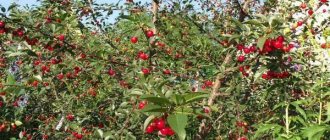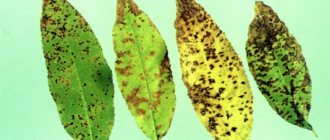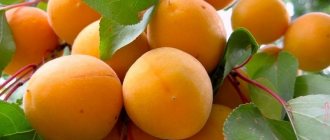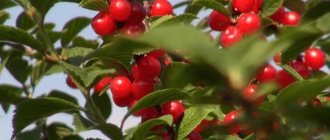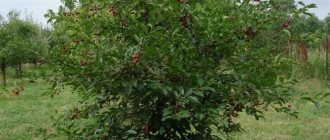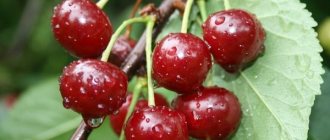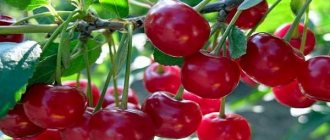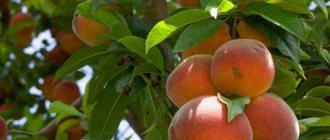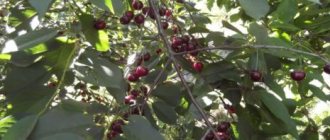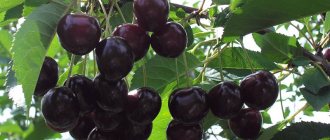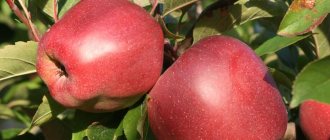Why graft cherries?
Tree grafting is an agrotechnical technique that allows you to propagate fruit trees. To perform the procedure, part of one tree is attached to another so that fusion occurs and the formation of one organism with improved characteristics.
Did you know? The oldest cherry tree in the world that bears fruit is a 150-year-old plant, reaching a height of 12 m and growing in the UK.
.
- The main advantages of cherry grafting are:
- preservation of varietal characteristics, which cannot be achieved by seed propagation of the plant;
- acceleration of the period of formation of the first fruits on a young tree - grafted cherries enter the fruiting period already 2-3 years after the manipulation, and plants that were grown from seeds begin to bear fruit only after 5-8 years;
- rejuvenation of the plant - a young cutting is grafted onto an old tree, restoring the productivity of the plant;
- increasing the plant’s resistance to common diseases of stone fruit trees and unfavorable environmental conditions;
- combining the qualities of several varieties to obtain a new sample with improved characteristics;
- saving space on the territory - instead of several varieties of cherries on one tree, you can graft and get a harvest of different fruits;
- the opportunity to save a tree broken during bad weather, whose roots were preserved in the soil.
The main disadvantage of cherry grafting is the weak strength at the site of plant growth. When choosing certain methods of manipulation, there is a risk of poor survival of the grafted cuttings.
Further care
After the graft has taken root well on the main plant, it is released from the cellophane cap and allowed to grow freely in the air, but for some time it is necessary to ensure good fixation to the trunk, since it is not strong enough and can be damaged by strong winds or awkward movement. To do this, it is necessary to apply a kind of splint to the place of fusion and wind it well with the main trunk and with the graft.
It is also necessary to take care of eliminating young shoots coming from the mother tree, which will take away the vitality and nutrition of the graft.
When is the best time to do it?
The best time to graft cherry trees is spring. During this period, sap flow processes are activated, and the likelihood of rapid survival of the cuttings is highest. Usually the cherry tree awakens in early April, if the air temperature does not drop below +7°C.
If it is cold outside and the frosts do not subside, the awakening of the tree occurs in the middle and end of April. In this regard, the optimal time for cherry grafting should be selected based on weather conditions.
Find out also about the features of planting cherries in the fall.
How to protect a grafted tree from winter cold?
In early November, before the onset of cold weather, the tree bends down to the ground and is fixed with hooks or ties to a peg.
In the first year after vaccination, special care must be taken. The tree is still too fragile, so you need to bend it down by holding the trunk and without removing the strapping. The harness, by the way, can only be removed next spring. In subsequent years, there will be no need to be careful, and the bush can be bent using oppression and boards. Of course, it is better to initially choose a snowy place, even at the expense of lighting. Cherries can also bear fruit in shaded areas.
It is important to bend the cherry bush to the ground, it is not necessary to cover it, the snow will do it itself
Thanks to cherry grafting, cherries can now also be considered an affordable delicacy
What can you graft cherry onto?
It is usually recommended to graft cherries onto young trees. Old plants are not very suitable as a rootstock - the cuttings take root poorly and produce a meager harvest. The ideal option for grafting cherries is a cherry tree of the same variety if there is a need to save the tree from death.
In addition, cherry cuttings are well compatible with other rootstocks:
- any cultivated variety of cherry - when choosing a variety, pay attention to the flowering dates of the combined plants (they must coincide);
- wild - wild cherry is well suited as a rootstock, and there is practically no risk of rejection of the young cutting;
- bird cherry - cherry cuttings will take root well on frost-resistant bird cherry, which is the best option to get a cherry harvest in cold northern regions;
- plum - refers to strong rootstocks, takes cherry cuttings well, a plant grafted onto a plum has increased resistance to diseases and unfavorable environmental conditions;
- cherry plum is a universal rootstock that is well suited for grafting cherries and can also increase the resistance of stone fruits to diseases and sudden changes in weather conditions.
Cherry, bird cherry, cherry plum, plum and even currants take root well on a cherry tree.
Video: how to turn cherry plum into cherry
How to plant cherries in the spring at home?
There are several ways to graft cherries at home. Let's look at the features of step-by-step implementation of each.
Handle by bark
It is recommended to graft cherries onto the bark in the spring, when the juices are just beginning to activate and the bark can be easily separated from the wood. This method is usually used in cases of significant differences in the diameter of the rootstock and scion.
Important! If the diameter of the rootstock is small, 1 cutting is grafted; on mature trees, several cuttings are allowed to be attached, but not more than 4 per rootstock.
The procedure should consist of the following steps:
- Cuttings are prepared taking into account the diameter of the rootstock. The base is cut to obtain a cross section.
- The area on the rootstock where the grafting will take place is cut with a hacksaw and thoroughly cleaned to obtain a smooth surface.
- On the resulting stump, several cuts are made in the bark up to 5 cm in length.
- In the cracks that were formed by cutting the bark, prepared cuttings are installed so that their cut fits tightly to the wood of the rootstock.
- The junction of the scion and rootstock is tightly tied with grafting tape and covered with garden varnish.
Budding
The method of grafting cherries with buds is called budding, which is used in summer or autumn. The optimal time to perform the manipulation is the end of July.
Budding is performed as follows:
- 3 days before the procedure, the rootstock should be prepared: water well and remove all side shoots that are located at the bottom of the main trunk.
- The cuttings that will be used as a scion should be cut on the day of budding to achieve good survival. The leaves are torn off the cuttings, leaving petioles that will allow you to monitor the process of survival.
- Using a budding knife, a bud with a small area of bark that surrounds it and a petiole is cut out from the cutting.
- In the rootstock, at a height of 10 cm from the soil, a T-shaped cut is made in the bark, touching the wood, and the previously prepared bud is inserted into the resulting hole, tightly connecting the edges of the bark.
- The bark on the rootstock is fixed with a special tape, leaving the petiole outside.
- Next, you need to monitor the petiole; if after 2 days it falls off, this will indicate a successful manipulation.
- A month later, it is necessary to remove the tape and treat the damaged area on the rootstock with garden varnish.
- In early spring, the trunk with shoots, which was located above the bud, should be cut down to make the main shoot from the bud.
T-shaped cut of the bark with a cutting with one bud.
Into the cleft
It is possible to graft a cutting into a split if the thickness of the rootstock is more than 10 cm, and the cutting does not exceed 2 cm in thickness.
The procedure is performed as follows:
- The rootstock is prepared; for this, the tree trunk is cut with a hacksaw, leaving a stump up to 50 cm in height. You can cut off not the entire trunk, but one of the thick, strong shoots to preserve part of the plant with the same fruits.
- The prepared rootstock is split in the center into 2 parts with a sharp knife to a depth of 3 cm.
- The stalk is cut in such a way as to obtain a sharp “tip” at the base. The length of the pointed part should exceed the diameter of the scion by 3 times. A high-quality scion should have at least 2 buds left after pruning.
- The top cut point on the cutting, which is located immediately under one of the buds, should be treated with garden varnish. In a similar way, it is better to prepare 2 cuttings, in case one does not take root.
- The cuttings are placed in the center of the split rootstock so that their cut fits tightly to the wood.
- The scion is tightly tied with a special tape.
- The cracks are sealed with garden pitch.
How long will it take for the vaccine to take root?
Regardless of the method of grafting cherries, the survival of the cuttings occurs within 1.5–2 weeks if the procedure was carried out correctly. When the specified time has passed, it is necessary to check the condition of the scion. If buds begin to grow on the scion, it means the procedure was successful.
Important! It is impossible to remove the grafting tape from the rootstock; within a year, the grafting site will be overgrown with callus.
-
a seal that will firmly fix the scion.
An indicator of the effectiveness of cherry grafting will be the result of the first harvest 2-3 years after the manipulation. By the end of summer, shoots from 20 to 100 cm long should grow from young buds.
Spring grafting
One type of popular grafting is spring grafting, produced using cuttings. Rootstocks for this method are harvested in the fall or in the first month of winter. Take cuttings at least 50 centimeters long. For this purpose, branches more than a year old are used. They can be stored, in addition to the methods described above, by snowing. This method involves tying the cuttings into tight bunches, wrapping them in plastic bags, and covering them with a layer of at least half a meter when snow falls. Such a snowdrift is covered with sawdust or peat. These storage facilities are placed on the north side of the house so that the snow does not melt for a sufficiently long time. The optimal air temperature is at least 2, but not more than 10 degrees below zero.
Useful tips
To get a high-quality result from cherry grafting, it is recommended to pay attention to the advice of experienced gardeners:
- Prepare tools in advance (treat them with special disinfectants or alcohol solutions) that will come into contact with the wood of the rootstock and scion, so as not to introduce an infection that can destroy the plants.
- The grafting procedure should be carried out very quickly so that the sections do not dry out, this way you can achieve good adhesion and survival.
- In addition to grafting tape, polyvinyl chloride or polyethylene film can be used to secure the scion.
- Cut off all new shoots that grow under the grafting site - they can cause poor survival or death of the cutting.
- When choosing cuttings for a scion, give preference to healthy young shoots 12 cm long that have at least 5 buds.
Did you know? Cherry pits, like tree branches, contain amygdalin, which in the human body turns into hydrocyanic acid and can cause severe poisoning.
Cherry grafting is a simple manipulation that is recommended to be carried out in the spring to achieve the desired result. Depending on the chosen method of manipulation, it has its own characteristics that should be taken into account for good survival of the scion.
